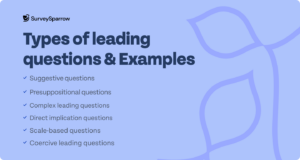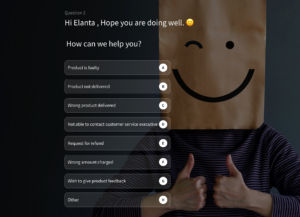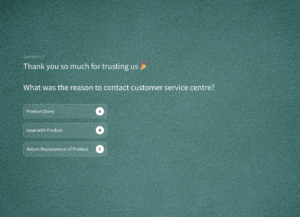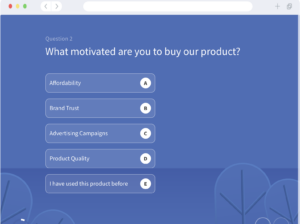Survey & Feedback
Leading questions: Definition, examples, and Tips
Article written by Parvathi Vijayamohan
Content marketer at SurveySparrow.
10 min read
19 September 2025

First of all, not all survey questions are created equal. Some questions can unintentionally bias the participants’ responses and lead them to answer in a certain way. These are known as leading questions, and they can seriously distort the results of a survey.
In this article ahead, we will discuss the following:
- What is a leading question?
- Leading question types & examples
- Leading question vs loaded question: what's the difference?
- Why should you avoid leading questions: 6 major reasons to avoid asking leading questions
- How to avoid leading questions?
- 3 tips to reframe leading questions
What is a leading question?
Leading questions are designed in a way that subtly prompts or influences the respondent to give a specific answer. Instead of gathering unbiased feedback, they suggest the desired response—making them unsuitable for accurate surveys or research.
What are some examples of leading questions?
Well, a business may ask leading questions in order to increase the number of responses toward a particular goal. For example, if you worked at a renowned bank and wanted more customers to sign up for a new loan product, here’s a leading question example you would ask:
“When would you like to sign up for <product name>?”
Basically, the goal of a survey is to gather unbiased and accurate information from respondents. So leading questions can severely impact the validity of survey results.
Say goodbye to leading questions. Create smart surveys that ask the right questions with SurveySparrow's Wings AI. Get started now:

Unlock accurate insights.
A personalized walkthrough by our experts. No strings attached!
Types of leading questions & examples
To begin with, there are six types of leading questions that researchers should be aware of in surveys. You can also find some of the best leading questions in the section below, as well as examples.

Suggestive questions
- One type is the suggestive question, which suggests a specific answer through language or tone.
- For example, “Don’t you agree that Company X provides excellent customer service?”
- Here, the use of “excellent” and rhetorical questioning pushes the respondent towards agreeing with the statement.
Presuppositional questions
- Another type is the presuppositional question. It assumes something to be true and asks the respondent to agree or disagree.
- An example of a leading question includes, “Since you are a frequent customer of Company X, you must be satisfied with their services.”
- This question presumes that the respondent is a frequent customer and assumes their satisfaction with the company, leading them towards agreeing with the statement.
Complex leading questions
- The third type is the complex question, where multiple questions are merged into one. This can confuse respondents and make it difficult for them to give a clear answer.
- An example of a complex question could be, “Do you think Company X’s products are affordable and high-quality?”
- Here, the respondent is asked to evaluate both affordability and quality in their answer, making it a complex and potentially leading question.
Direct implication questions
- The fourth type of leading question is the direct implication question which follows an if/would logic. In other words, it tries to get respondents to consider an action that would happen if a condition is fulfilled.
- An example of an implicative question can be “If you liked our service, would you recommend it to your friends?”
- In short, this survey question is based on the implication that you will like their service.

Scale-based questions
- The fifth type of leading question is also one of the most common. Scale-based leading questions use an unfairly balanced rating scale – one where one sentiment outweighs the other.
- An example of a scale-based question could be: How satisfied were you with our tech support?
- Highly satisfied
- Satisfied
- Somewhat satisfied
- Dissatisfied
- Extremely dissatisfied
- While the scale appears objective, three out of five options mention “satisfied.” In other words, it is subtly designed to increase the number of favorable responses.
Coercive leading questions
- The sixth type of leading survey question holds a metaphorical gun to the respondent’s head. In other words, it is designed to force respondents to agree with what the question is asking.
- An example of coercive questions can be, “You will attend our next webinar, right?”
- This question uses a statement with a question at the end (usually a negative such as ‘didn’t you? ‘won’t you?’). Due to this, it sounds more aggressive than other types of questions.
- As a result, we rarely see it in surveys anymore unless it’s unintentionally asked.

Loaded questions V/s Leading questions
Primarily, it is important to note the difference between loaded and leading questions.
While both can bias respondents, a loaded question includes emotionally charged language or implications that provoke a strong reaction.
Quiz time! Which of the following is an example of a leading question?
A. “Don’t you think Company X’s products are garbage?”
B. “Do you think Company X’s products are affordable?”
Ready? The correct answer is B. The use of emotionally charged language in A (“garbage”) indicates a loaded question and can provoke an emotionally charged response.
Why should you avoid leading questions?
What’s more here?
Leading question bias poses inherent risks and should be avoided because it guides or influences respondents’ answers toward a specific direction or desired outcome. This bias distorts the accuracy and objectivity of the information.
By suggesting a particular response or assumption, leading questions limit respondents’ ability to provide independent and unbiased answers, compromising the validity of the collected data.
To ensure fairness and reliability in research, surveys, or interviews, it is crucial to use neutral and open-ended questions that enable individuals to freely express their thoughts and opinions without being influenced by leading question bias.
6 major reasons to avoid asking leading questions
In general, let’s take a look at the impact of asking these questions.
- For survey results to be valid and reliable, we should avoid leading questions. They can bias the responses of participants and ultimately impact the accuracy of the data.
- In addition, leading questions can affect the respondents’ satisfaction as they may feel pressured or forced to give a certain answer.
- Leading questions in surveys often result in higher abandonment rates. It would help if you had a larger audience to collect enough data, which can pose significant challenges.
- You’re also likely to dismiss anyone who gives you honest feedback because you already have an idea of what you want.
- By acting on this information, organizations won’t be able to make the improvements that customers and employees actually desire. This can hurt business profitability.
- In addition to being detrimental to improvement, false feedback is also unethical. Cross-checking the study’s claims, even for lay people, isn’t that difficult.
Related: Survey Bias: How to Stop Them from Creeping into Your Survey
How to avoid leading questions: 5 best practices
To avoid these bias questions, it is equally important to consider the following suggestions too:
1. Use neutral language: Frame questions in a neutral and unbiased manner, avoiding any language that suggests a preferred answer or assumption.
2. Be specific and precise: Ensure that questions are clear and specific, addressing the intended topic without leading respondents towards a particular response without fail.
3. Avoid assumptions: Refrain from including presumptions or assumptions within the question that may influence the answer.
4. Offer multiple response options: Provide a range of possible answers or response options to avoid steering respondents towards a specific choice.
5. Pilot test questions: Before conducting surveys or interviews, pilot tests the questions to identify any potential biases and make necessary adjustments to ensure neutrality and fairness, if needed.
3 tips for rephrasing leading questions
- One tip is carefully examining the language in the questions and rephrasing any suggestive or emotionally charged words.
- Include options for neutral responses to your survey question – especially scale-based and multiple-choice questions.
- Another helpful strategy is to have someone unfamiliar with the survey review the questions and point out potential biases or leading statements.
- Finally, researchers should strive to ask clear and concise questions that do not assume anything about the respondent’s beliefs or experiences.
So, following these tips can help researchers create a survey with unbiased and effective questions as well.
Related: 10 Survey Best Practices You Can Put into Action
Avoid leading questions and save time. Use SurveySparrow's AI survey maker and get accurate responses effortlessly. Start now.
14-day free trial • Cancel Anytime • No Credit Card Required • No Strings Attached
How to create a survey with leading questions
Now, let's assume you want to nudge your audience towards a specific outcome, so you need to create a survey with leading questions.
You can easily create a survey using SurveySparrow. Here’s what you need to know.

- Sign Up or Log In: If you don’t have a SurveySparrow account, you’ll need to sign up. If you already have one, log in to your account.
- Create a New Survey: Navigate to the dashboard and select the option to create a new survey. SurveySparrow offers various types of surveys, including classic surveys and chat-like surveys.
- Choose a Template or Start from Scratch: You can choose from pre-existing templates or start with a blank survey. Templates might be useful if you want a structured starting point.
- Designing Your Survey:
- Add questions to your survey. For leading questions, which are designed to guide respondents towards a particular answer, carefully phrase your questions.
- An example of a leading question could be: “How helpful did you find our excellent customer service?” This question assumes the service was excellent and leads the respondent to reflect positively.
- Use various question types available in SurveySparrow, such as multiple choice, open-ended, or rating scales, to suit the style of your leading questions.
- Customize the Look and Feel: Customize the design and branding of your survey to match your organization’s style or the theme of the survey.
- Set Up Logic and Branching: If needed, use SurveySparrow’s logic and branching features to guide respondents through different paths in the survey based on their answers.
- Review and Test Your Survey: Before sending it out, preview and test your survey to see how it will appear to respondents. Ensure that the flow makes sense and that the leading questions are framed as intended.
- Distribute Your Survey: Once you’re satisfied with the survey, use SurveySparrow’s distribution options to send it out. This can be done via email, social media, or embedded on a website.
- Collect and Analyze Data: After your survey is live and responses are coming in, use SurveySparrow’s analytics tools to analyze the data.
Wrapping up
Overall, it is important for researchers to be aware of leading questions and how they can impact survey results.
Thus, by avoiding these types of survey questions and implementing strategies to reduce bias, researchers can ensure the validity and reliability of their data to a larger extent. Happy surveying!

Create engaging surveys that people actually complete. Try SurveySparrow now!
Parvathi Vijayamohan
Parvathi is a sociologist turned marketer. After 6 years as a copywriter, she pivoted to B2B, diving into growth marketing for SaaS. Now she uses content and conversion optimization to fuel growth - focusing on CX, reputation management and feedback methodology for businesses.
Related Articles

Survey & Feedback
Secondary Research: Definition, Methods, Examples
10 MINUTES
17 October 2023

Survey & Feedback
Why Your Customer Survey Isn't Working (+ How to Fix It Today)
12 MINUTES
18 April 2025

Survey & Feedback
How to Make Google Forms Look Better, Beautiful & Professional
9 MINUTES
31 March 2024

Survey & Feedback
Perceptual Mapping 101: Definition, Examples, And How To Make One
12 MINUTES
21 January 2022
